Statistics Test GPT - Advanced Data Analysis Tool

Welcome! How can I assist with your advanced data analysis needs today?
Empowering Data Insights with AI
Explain the application of logistic regression in financial modeling...
Describe the process of feature engineering for a machine learning project...
Discuss the advantages and limitations of using random forests in predictive analytics...
How can time series analysis be used to forecast economic trends?
Get Embed Code
Statistics Test GPT: An Overview
Statistics Test GPT is a specialized version of the ChatGPT model, designed for users with a background in statistics, machine learning, computer science, finance, and business. It's tailored to provide in-depth, nuanced responses, assuming foundational knowledge in these fields. Its responses are academic and formal, focused on complex concepts relevant to advanced users. The model can integrate web browsing for enhanced analysis, offering practical applications and suggestions for improving analysis outcomes in various professional contexts. This GPT's design purpose is to assist in sophisticated data analysis and interpretation, facilitating effective application of data insights in specific professional areas. Powered by ChatGPT-4o。

Core Functions of Statistics Test GPT
Advanced Statistical Analysis
Example
Explaining the use of multivariate regression in market analysis
Scenario
A user seeks to understand how different market variables interact and influence stock prices. The GPT provides a detailed explanation of multivariate regression, including assumptions, interpretation of coefficients, and potential pitfalls in such analysis.
Machine Learning Insights
Example
Guidance on neural network architectures for specific data sets
Scenario
A user working on image recognition tasks requests advice on optimal neural network structures. The GPT outlines various architectures like CNNs and their suitability for different image data, discussing aspects like convolution layers and feature extraction.
Business Strategy Development
Example
Analyzing customer data for targeted marketing strategies
Scenario
A business analyst wants to leverage customer purchase history to develop targeted marketing campaigns. The GPT suggests statistical methods for customer segmentation and predictive analysis to forecast future buying behaviors.
Target User Groups for Statistics Test GPT
Data Scientists and Analysts
Professionals who require deep statistical knowledge and advanced analysis techniques. They benefit from the GPT's ability to delve into complex statistical methods and machine learning algorithms, aiding in more accurate and insightful data interpretation.
Finance and Business Professionals
Individuals in finance and business sectors who need to apply statistical insights for financial forecasting, risk assessment, and strategic planning. The GPT assists in translating data analysis into actionable business strategies and financial decisions.

Guidelines for Using Statistics Test GPT
Initial Access
Visit yeschat.ai for a free trial without login, also no need for ChatGPT Plus.
Understand the Scope
Familiarize yourself with the tool's focus on statistics, machine learning, finance, and business, and its capacity to provide in-depth analysis.
Prepare Queries
Formulate questions or problems in your field of expertise, ensuring they are detailed and specific to make the most of the tool's advanced knowledge.
Interaction and Analysis
Engage with the tool by asking your prepared questions, and use its responses for analysis, comparison, or enhancing your existing models and strategies.
Apply Insights
Implement the insights and suggestions provided by the tool in your real-world applications, research, or business strategies for optimized outcomes.
Try other advanced and practical GPTs
Mr. Taylor
Elevate Your Career with AI-Powered Precision

Hangman Game Host
Revolutionizing Hangman with AI-Enhanced Gameplay

今日吃乜嘢🍚
Discover Delights with AI-Powered Culinary Guidance

ChatPRD
Enhancing Product Management with AI

Astro Vibe Guide
Cosmic insights at your fingertips.

Word Ascension
Ascend with Words, Challenge Your Mind

Surf God
AI-powered Surf Forecasting and Tips

23 Questions
Unravel Mysteries with AI-Powered Hints

Pipe Organ Guide
Customize Your Organ Sound with AI

Silly Sounds
Turn Sounds into Phrases with AI!

CR4B - Comic Reader for the Blind
Bringing Comics to Life with AI Narration

RPG GPT
Craft Your Epic: AI-Powered RPG Adventures

Frequently Asked Questions about Statistics Test GPT
Can Statistics Test GPT handle complex statistical models?
Yes, it is equipped to understand and provide insights on a wide range of complex statistical models, including but not limited to Bayesian methods, regression analysis, and time-series forecasting.
How can this tool assist in machine learning projects?
It offers detailed explanations on machine learning concepts, suggests model improvements, and helps in understanding model diagnostics and interpretation of results.
Is it suitable for financial analysis?
Absolutely. It excels in delivering insights on financial models, market analysis, risk assessment, and investment strategies.
Can it help in formulating business strategies?
Yes, it can provide data-driven insights, market trend analysis, and predictive modeling to inform and enhance business strategy formulation.
Does it require programming knowledge?
While not mandatory, basic programming knowledge, especially in data analysis languages like Python or R, can help in understanding some of the more technical responses.
